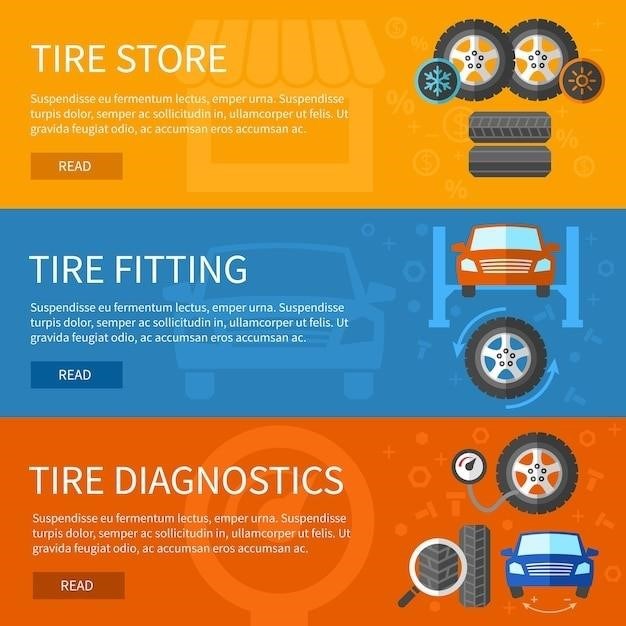ATV Tire Size Guide⁚ Understanding the Basics
Choosing the right ATV tire size is crucial for optimal performance, handling, and overall riding experience. This guide will help you understand the basics of ATV tire sizes, how to decipher the code behind them, and how to select the best tires for your off-road adventures.
Understanding ATV Tire Sizes
ATV tire sizes are essential for determining the overall height, width, and rim diameter of the tire. Understanding these measurements is crucial for choosing the right tires for your ATV and ensuring a safe and enjoyable riding experience. Tire size directly impacts your ATV’s performance, handling, and even its appearance. Larger tires generally provide better ground clearance and traction in challenging terrain, while smaller tires offer improved handling and agility on smoother surfaces. When selecting tires, consider your riding style, terrain, and the specific requirements of your ATV.
ATV Tire Size Format
ATV tire sizes are typically expressed using a three-number format, often separated by dashes, forward slashes, or an “x.” This format is commonly seen as 25-10-12, 25/10/12, or 25x10x12. Each number represents a specific dimension of the tire⁚ the overall height, the overall width, and the rim diameter, all measured in inches. For instance, a tire with a size of 25-10-12 would be 25 inches tall, 10 inches wide, and designed to fit a 12-inch rim. Understanding this format allows you to quickly identify the key dimensions of an ATV tire and compare different options for your specific needs.
Standard vs. Metric Tire Sizing
ATV tires can be sized using either standard or metric formats. Standard sizing, more prevalent in the ATV world, uses inches for all measurements, appearing as “Tire Diameter (inches) x Tire Width (inches) ー Wheel Diameter (inches).” For example, a 26×10-12 tire indicates a 26-inch diameter, 10-inch width, and a fit for a 12-inch rim. Metric sizing, less common for ATVs, utilizes millimeters for width and inches for rim diameter, often written as “Tire Width (millimeters)/Aspect Ratio (%) ー Wheel Diameter (inches).” An example would be 215/80R14, where 215 represents the width in millimeters, 80 is the aspect ratio (tire height as a percentage of width), and 14 is the rim diameter in inches. Understanding the difference between these formats is crucial for accurately comparing and choosing the right tires for your ATV.

Choosing the Right ATV Tire Size
Selecting the correct ATV tire size is crucial for performance, handling, and safety. Several factors influence this choice, including your riding style, terrain, and ATV’s intended use.
Factors to Consider
When choosing the right ATV tire size, several factors come into play. First, consider your riding style. Are you primarily a trail rider, a mud enthusiast, or a sand dune enthusiast? Different terrains require different tire types and sizes. For example, trail riders often prefer tires with a knobby tread pattern for traction, while mud riders opt for tires with deep lugs for maximum grip in slippery conditions. Second, consider your ATV’s intended use. If you plan to use your ATV for work or hauling, you’ll need a tire that can handle the extra weight. Third, consider your ATV’s suspension. If you have a lifted ATV, you may need larger tires to maintain proper ground clearance;
Impact of Tire Size on Performance
Tire size significantly impacts an ATV’s performance. Larger tires generally provide better ground clearance, which is beneficial for navigating rough terrain and obstacles. They also offer a larger contact patch, resulting in increased traction and stability. However, larger tires can increase the ATV’s overall weight and affect acceleration and fuel efficiency. Smaller tires, on the other hand, offer better agility and maneuverability, making them ideal for tight trails and technical riding. Ultimately, the optimal tire size depends on the specific riding conditions and the intended use of the ATV.
Decoding ATV Tire Size Numbers
ATV tire sizes are typically expressed as a series of three numbers separated by dashes, slashes, or an “x”. These numbers represent the tire’s overall height, width, and rim diameter.
First Number⁚ Overall Tire Height
The first number in an ATV tire size designation represents the overall height of the tire, measured in inches. This measurement is taken from the bottom of the tire to the top of the tire, including the sidewall and tread. For example, a tire size of 25×8-12 indicates that the tire is 25 inches tall. It’s important to note that this measurement is taken when the tire is properly inflated to its recommended pressure.
The overall tire height is a critical factor in determining the ground clearance and ride height of your ATV. Taller tires provide more ground clearance, allowing you to tackle rough terrain more easily. However, taller tires can also affect the steering and handling of your ATV, making it feel more sluggish. Therefore, choosing the right tire height is important for balancing performance and ride comfort.
Second Number⁚ Overall Tire Width
The second number in an ATV tire size designation represents the overall width of the tire, measured in inches. This measurement is taken across the widest point of the tire, including the sidewall and tread. For example, a tire size of 25×8-12 indicates that the tire is 8 inches wide. This measurement is crucial for determining the stability and traction of your ATV.
Wider tires provide a larger contact patch with the ground, resulting in increased stability and traction, particularly in loose or soft terrain. However, wider tires can also increase the turning radius and make it more difficult to maneuver in tight spaces. A balance between tire width and handling is important for a smooth and enjoyable riding experience. You can also select tires with specific tread patterns for different types of terrain, like knobby tires for mud and sand, or smooth tires for hard-packed surfaces.
Third Number⁚ Rim Diameter
The third number in an ATV tire size designation specifies the diameter of the wheel rim, also measured in inches. This number is critical for ensuring proper fitment and compatibility between the tire and the wheel. For instance, a tire size of 25×8-12 indicates that the tire is designed to fit a wheel rim with a diameter of 12 inches.
Selecting the correct rim diameter is essential for safe and reliable operation. A mismatch between the tire and rim can lead to improper mounting, instability, and potential damage to both the tire and wheel. It’s crucial to verify the rim diameter recommended by the ATV manufacturer or consult with a tire specialist to ensure you choose the right combination for your vehicle. You can also consider upgrading your wheels to a larger size for a more aggressive look or to accommodate larger tires for improved performance.

ATV Tire Size Charts and Resources
Finding the right ATV tire size can be easier with the help of tire size charts and online resources. These tools provide valuable information on compatible tire sizes for various ATV models and brands.
ATV Tire Size Charts by Brand
Many ATV manufacturers and tire brands offer comprehensive tire size charts specifically tailored to their products. These charts typically list the original equipment (OE) tire sizes for different ATV models, years, and variations. They can be extremely helpful when looking for replacement tires that match your ATV’s stock specifications. You can often find these charts on the manufacturer’s website, in their owner’s manuals, or on specialized ATV parts retailers’ websites. These charts usually include details like the tire diameter, width, and rim diameter, making it easier to find the perfect fit for your ATV.
Online Resources for ATV Tire Information
The internet is a treasure trove of information on ATV tires, offering a wealth of resources to help you make informed decisions. Websites like Dennis Kirk, Partzilla, and MudThrowers provide detailed guides, articles, and even tire size calculators. These online platforms can guide you through understanding tire sizes, deciphering the codes, and selecting the right tires for your riding style and terrain. You can often find brand-specific tire size charts, application guides, and forums where experienced ATV enthusiasts share their knowledge and recommendations. Leveraging these online resources can save you time and ensure you choose the perfect tires for your ATV.
Tips for Choosing and Installing ATV Tires
Choosing the right ATV tires is essential for optimal performance and safety. Consider factors like terrain, riding style, and your ATV’s specifications. It’s crucial to ensure proper fitment to avoid damage or complications.
Choosing the Right Tire Type
ATV tires come in various types, each designed for specific terrain and riding conditions. Here’s a breakdown of common ATV tire types to help you choose the best fit for your needs⁚
- All-Terrain Tires⁚ These tires offer a versatile tread pattern suitable for a wide range of terrain, including trails, dirt roads, and moderate mud. They provide good traction and durability, making them a popular choice for general-purpose riding.
- Mud Tires⁚ Designed for extreme mud conditions, these tires feature deep lugs and aggressive tread patterns to provide maximum grip and self-cleaning abilities. They excel in muddy and slippery terrain but may compromise performance on hard-packed surfaces.
- Sand Tires⁚ Constructed with a wide, paddle-like tread pattern, these tires are designed for loose sand and dune riding. Their unique design helps to disperse sand and provide optimal traction on soft, shifting surfaces.
- Street Tires⁚ These tires are designed for paved surfaces and offer smooth, quiet riding with minimal noise. They may not be suitable for off-road use due to their lack of traction on rough terrain.
When choosing a tire type, consider your primary riding terrain, your riding style, and the specific features that best suit your needs.
Ensuring Proper Fitment
Proper tire fitment is crucial for safe and efficient ATV operation. Incorrect fitment can lead to handling issues, reduced performance, and potential damage to your ATV. Here’s what you need to know⁚
- Tire Size⁚ Ensure that the new tires are the correct size for your ATV, matching the original equipment manufacturer (OEM) specifications or any modifications you’ve made. Refer to your owner’s manual or consult a reputable tire dealer for guidance.
- Rim Diameter⁚ The tire’s rim diameter must match the size of your ATV’s rims. Incorrect rim diameter can cause the tire to mount improperly or even damage the rim.
- Clearance⁚ Ensure that the new tires have sufficient clearance with your ATV’s suspension components, bodywork, and other parts. Excessive rubbing can cause damage and affect handling.
If you’re unsure about proper fitment, it’s always best to consult a professional mechanic or tire specialist for assistance.
Professional Installation Recommendations
While some ATV owners may feel comfortable installing tires themselves, it’s highly recommended to seek professional installation, especially for more complex situations. Here’s why⁚
- Specialized Equipment⁚ Tire mounting and balancing require specialized equipment that may not be readily available to most ATV owners. Professional shops have the tools and expertise to ensure proper installation.
- Safety⁚ Tire installation can involve heavy lifting and potentially dangerous situations. Professionals are trained to handle these tasks safely, reducing the risk of injury.
- Expertise⁚ Experienced mechanics can properly mount and balance tires, ensuring they are securely attached and properly balanced for optimal performance and handling.
- Warranty⁚ Many tire manufacturers offer warranties on their products, but these may be voided if tires are not installed professionally. Professional installation provides peace of mind and protects your investment.
For a safe and hassle-free experience, consider having your ATV tires professionally installed by a qualified mechanic.
